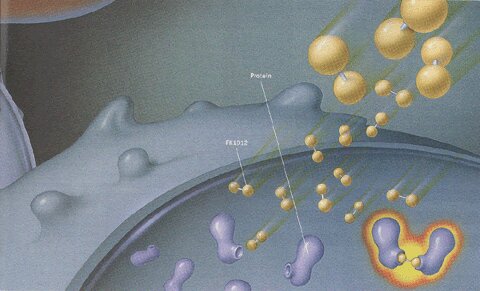Several years ago, in collaboration with Stuart Schreiber’s lab at Harvard we developed a way to use small molecules to rapidly and reversibly control the proximity of proteins within living cells and organisms. Induced proximity is probably one of the most frequently used biologic regulatory mechanisms, underlying post transcriptional modifications like phosphorylation, methylation, ubiquitination and allosteric changes induced by ligand binding. Bringing two molecules in close proximity vastly increases reaction rates. Indeed, the probability of an effective collision between two molecules is a third order function of distance. Using small molecules and tagged proteins we were able to start and stop intracellular reactions allowing detailed biochemical understanding of the ensuing biologic responses. With this approach we and others have been able to gain insight into receptor mechanisms, signal transcription, transcription and epigenetic regulation. These studies lead to the founding of Arid Gene Therapeutics and the development of systems for fine-tuned regulation of therapeutic genes such as erythropoietin for anemia. These approaches largely used tagged molecules and genetic systems that limited our studies to investigational purposes and gene therapy with modified proteins.
More recently our focus has turned toward using this fundamental biologic regulatory mechanism to advance therapeutic goals. For this we are going beyond using tagged proteins and genetically modified systems and are presently developing ways of rewiring the cells internal circuitries to regulate genes and epigenetics using new classes of small molecules. We feel this will lead us to a new class of therapeutics aimed at many common diseases.

Publications from our lab illustrating the use of chemically induced proximity to investigate and control biologic processes.
Spencer et al Science 1993 The frist use of synthetic ligands and induced proximity to control signaling.
Ho et al Nature. 1996 Aug 29;382(6594):822-6 The use of CID’s to dissect mechanisms of transcription.
Holsinger et al PNAS The first use of synthetic ligands to control exchange factors
Biggar SR, Crabtree GR. EMBO 2001 The use of induced proximity to direct either binary or graded (analogue) transcriptional activation in yeast.
Spencer et al PNAS 1995 The first use of synthetic ligands to control non-receptor tyrosine kinases
Dynamics and memory of heterochromatin in living cells.
Hathaway NA, et al. Cell. 2012 Jun 22;149(7):1447-60. doi: 10.1016/j.cell.2012.03.052. Epub 2012 Jun 14. PMID: 22704655 The first use of induced proximity to transcriptional repression and epigenetic memory of endogenous genes.
Rapid and reversible epigenome editing by endogenous chromatin regulators.
Braun SMG, Kirkland JG, Chory EJ, Husmann D, Calarco JP, Crabtree GR. Nat Commun. 2017 Sep 15;8(1):560. doi: 10.1038/s41467-017-00644-y. PMID: 28916764
Spencer et al Current Biology 1996 and Belshaw et al Chem Biol 1996 The use of synthetic ligands to control death receptors
Gruber S,…, Nasmyth K. Cell. 2006 Nov 3;127(3):523-37. The use of induced proximity to control chromosome separation in yeast
Rivera et al Science 1999 1;283(5398):88-91 The use of CID’s to control secretion of therapeutic proteins
Ye X et al Science. 1999 Jan 1;283(5398):88-91 The use of CIDs for regulated gene therapy
